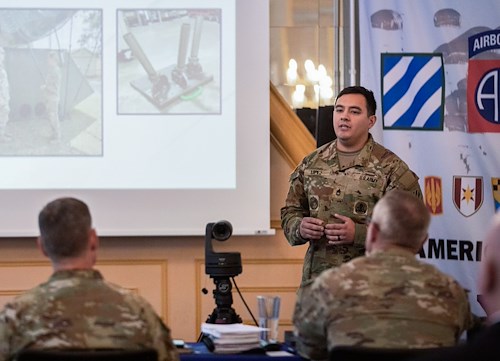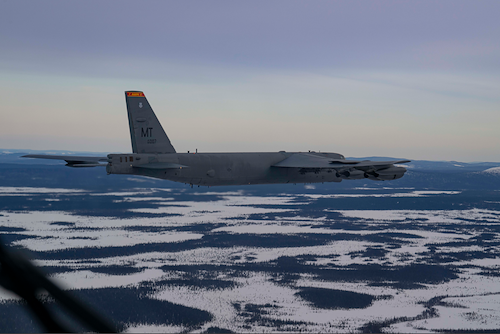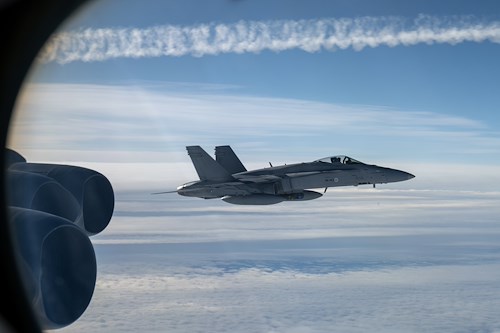Gallery contains 2 images
×
Photo 1 of 2
Dragons Duel at U.S. European Command innovation competition
U.S. Army Sgt. 1st Class Nathan Lopez, a former sniper who proposed a more efficient system for deploying camouflage netting over vehicles, was the gold medalist in the recent Dragon's Lair X, an innovation competition where military members pitch U.S. military leadership on potential breakthroughs
in military technology.
Photo by: XVII Airborne Corps Public Affairs
Photo 2 of 2
Dragons Duel at U.S. European Command innovation competition
U.S. European Command's Command Sgt. Maj. Rob Abernethy (second from left) and Sally Pfenning (second from the right), the command's Senior Executive Service director for Requirements and Resource Integration, served as hosts and judges during the recent "Dragon's Lair," an innovation competition where military members pitch U.S. military leadership on potential breakthroughs in military technology.
Photo by: XVII Airborne Corps Public Affairs
U.S. Army Capt. Douglas Thompson stood in front of a panel of generals and senior civilians, hands behind his back, and calmly took on one of the most vexing problems in modern warfare: Swarms of deadly suicide drones were much less expensive, and much easier to manufacture than the systems NATO Allies currently used to defeat them.
Splashed on a projection screen behind him was a picture of a Shahed 136, an Iranian-made suicide drone that Russia has used to bombard Ukraine. It costs just shy of $200,000 to make, but the most advanced missile shot from the U.S.-made Patriot surface-to-air missile system costs nearly $4 million per shot.
When you’re staring down hundreds of suicide drones, Thompson said, you were looking at a prohibitively expensive – and possibly unsustainable – ordeal.
The generals and civilian leaders nodded in grim agreement. It was the kind of problem that kept them awake at night, and that’s why they had come to this conference room on Patch Barracks, home of U.S. European Command (USEUCOM) in Stuttgart, Germany, for Dragon’s Lair X, an innovation competition where soldiers from up and down the ranks got to pitch U.S. military leadership on potential breakthroughs in military technology.
“This is kind of how we plant the seeds, and then we build an ecosystem around them to help them grow,” said U.S. Army Brig. Gen. John Cogbill, deputy commanding general of the XVIII Airborne Corps and a competition judge. “When you have a scenario like Ukraine, we’re seeing the ingenuity on the battlefield is being decisive. It’s not top-down-directed, it’s bottom-up. These are people on the front lines that are figuring out creative solutions to complex problems, and that’s what we’ve seen evidenced here today with these nine contestants.
Hosted by the XVIII Airborne Corps, the competition began in 2020 and has seen 10 iterations since. The winning ideas could see widespread adoption in the U.S. military – and even its NATO Allies.
Thompson’s idea was called the Low-Cost Attributable Soldier-Carried small Uncrewed Aerial System - or, more digestibly, LASSI - and the 3D-printed mock-up he passed around looked like an artillery shell with wings. “You wouldn’t believe how hard it is to get live interceptors through customs,” he said, drawing chuckles from the judges. “I got stopped twice just for these models.”
Carried in a backpack and launched by a soldier, LASSI would use artificial intelligence to find a target and lock on, destroying the incoming drone with a high-explosive warhead. Thompson had already flown a prototype, which he said reached 140 miles per hour (225 kilometers per hour). If produced at scale, he said, each LASSI unit could cost $5,000 or less. To fight a swarm of cheap suicide drones, Thompson proposed, NATO forces could use a swarm of cheaper suicide drones.
It was a provocative proposal to solve a problem ripped out of headlines, and the judges peppered Thompson with questions. Sally Pfenning, USEUCOM’s director of Requirements and Resource Integration (the part of the command tasked with determining its material needs, and how to fund them), was so intrigued that she said that she wanted to help Thompson develop his idea regardless of whether he took top prize at Dragon’s Lair.
At the end of the competition, Thompson walked away with a second-place win - a strong sign of potential for LASSI. The gold medal went to Sgt. 1st Class Nathan Lopez, a former sniper who proposed a more efficient system for deploying camouflage netting over vehicles. While perhaps not as eyebrow-raising as a drone hunter, Lopez’s creation solved what he described as a persistent problem with a potentially life-saving tool: camouflage netting was simply too cumbersome to deploy quickly and easily. In fact, he said, most soldiers simply skipped the netting altogether, leaving their vehicles vulnerable to detection.
With the Vehicle-Integrated Camouflage System, or VICS - a humble mounting bracket with a telescoping pole that can easily mount onto Army vehicles - soldiers can quickly deploy the netting in a way that takes full advantage of the netting’s ability to break up a vehicle’s shape and radar signature. With the system already designed and successfully tested in prototype form, Lopez asked for the judge’s support in producing the system to outfit all of the U.S. Army’s Third Infantry Division’s Armored Multi-Purpose Vehicles, or AMPVs.
Lopez’s pitch likely struck a chord with the judges: on Ukrainian battlefields, camouflage netting has proven crucial in evading detection by Russian scout drones. And since Lopez’s Third Infantry Division had just wrapped up a deployment to Eastern Europe, training hard alongside their NATO Allies, they were well acquainted with the need – and hassle – of using camouflage netting.
U.S. Army Maj. Gen. Martin Klein, deputy commanding general of the U.S. Army Reserve Command, didn’t hesitate in his endorsement. “It’s low-cost, and it gets our soldiers back to the basics,” he said.
Other ideas tackled problems that were less tangible, but no less important: U.S. Army Sgt. Galen Gant showed the judges Ammo Op, a browser-based system that reduces waste by helping units refine their ammunition requisition requests. He won third place. U.S. Navy Lt. Cmdr. Adam Waymouth presented “Scrybe,” an “AI-powered action officer” that would handle administrative tasks like compiling meeting minutes, giving leaders more time to tackle problems rather than completing administrative chores.
Ultimately, Cogbill said, all of the finalists presented tangible solutions to real problems, and all the products presented will see some form of support as they continue to grow and develop.
“Innovation is too important to be left to generals and sergeants major,” he said. “I think the best ideas come from the bottom. They’re the people closest to the problems.”










